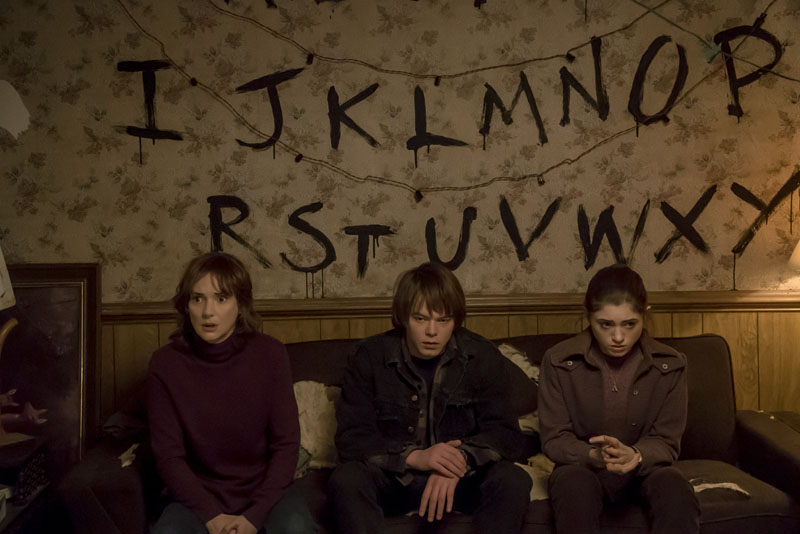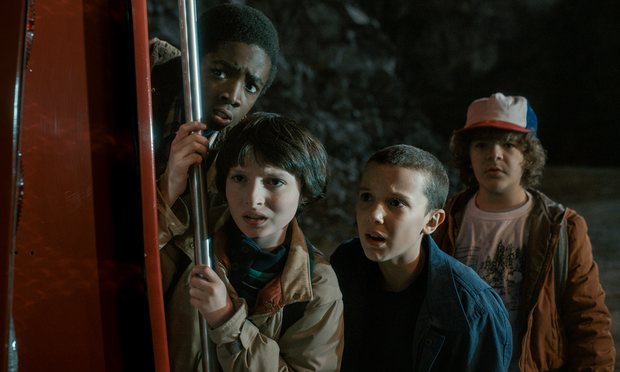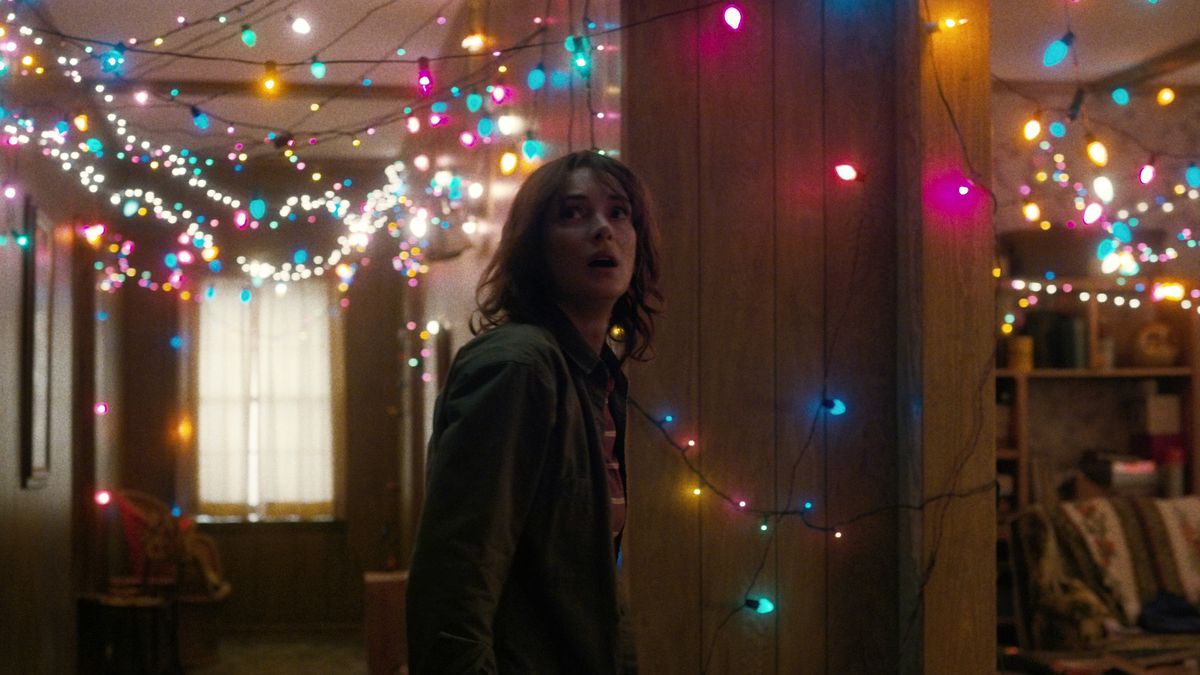
‘Stranger Things’ (10 out of 10) Created by Matt and Ross Duffer; Starring Winona Ryder, David Harbour, Millie Bobby Brown, Finn Wolfhard, Natalia Dyer; Streaming on Netflix
If you identify as a geek that grew up in the 1980’s, and you haven’t watched the Netflix series “Stranger Things” by now, then you really should get on that. In fact, make sure you watch it before you read this, because I’m taking a deep dive into some very spoiler-soaked territory with this one.
Even if you haven’t watched the show, it’s a safe bet that you know how it has sought (and succeeded) to capture some very specific vibes that are hardwired into the central nervous system of 80’s pop culture enthusiasts. There’s a little Hooper, a little Carpenter (John, not Karen), and just the right amount of “Hey you gu-uys!”
Rather than gush about how pretty much everything about this show resonated with me—right down to the decision to play New Order’s “Elegia” during a gut-wrenching funeral scene—we’re going take a look at the show’s homages to some timeless relics of the 1980’s, and how “Stranger Things” managed to weave them into its own frightfully good story.
Stephen Spielberg
It’s clear that Matt and Ross Duffer have a diversified portfolio of cultural influences from the 1980’s, but the work of Stephen Spielberg appears to be most prevalent. Few directors have the ability to capture Spielberg’s magical mixture of wonder, fear and heart, and it’s clear that the Duffers wanted “Stranger Things” to be a creature of that laboratory.
The most obvious nod to this vibe would have to be Richard Donner’s “The Goonies,” which was co-written by Spielberg. In “Stranger Things” our protagonists are a group of resourceful outcasts that just so happen to be endlessly watchable. Like the 1985 film, each member of the “Stranger Things” crew is a thoughtfully drawn out character, and a big part of the show’s success hinges on the great chemistry that they have together. Also like “Goonies,” the show’s casting directors have assembled some of the greatest actors without driver’s licenses that we’ve seen in recent memory. Most notably would have to be Eleven aka Elle, played by Millie Bobby Brown. Her ability to evoke an emotional spectrum that ranges from hysterical fear to unbridled rage with only a smattering of dialogue was definitely something special. Which is not to say that her A/V clubbing, Dungeons and Dragons-playing nerd posse wasn’t pulling their weight. Not since “E.T.” have we had so much fun watching a group of bike-riding geeks outwit shady government agents—along with scary-ass, interdimensional monsters. I love Mike Wheeler’s (Finn Wolfhard) unflinching leadership skills, I love how Lucas Sinclair’s (Caleb McLaughlin) sense of friendship triumphs over his cynicism, I love Dustin Henderson’s (Gaten Matarazzo) level-headed perspective, and I love Will Byers’s (Noah Schnapp) resourcefulness in the face of interdimensional kidnapping.
One of Spielberg’s few forays into the world of horror was co-writing Tobe Hooper’s classic “Poltergeist,” a film which scared the bejeezus out of us despite its PG rating. The scenes where Joyce (Winona Ryder) communicates with Will through various clusters of Christmas lights captures the same feels that “Poltergeist” gave us when Diane Freeling first makes contact with Carol Anne through the static of the living room TV. Props to Ryder for making me get all misty-eyed as she embraces a tangle of wires and light bulbs.

Slasher Flicks
In addition to the Upside Down, “Stranger Things” gives us a look into yet another bizarre, alternate dimension: That of the bored teenager in a small town. It’s a world that we primarily see through the eyes of Nancy Wheeler (Natalia Dyer), Mike’s older sister. When we first meet her, it’s obvious that her character is a reference to a strong line of straight-laced-but-not-too-straight-laced horror film heroines. Aside from the peculiar events that are happening in her town, her main concern is the fact that she’s landed a superhot boyfriend named Steve Harrington (Joe Keery), along with the pressures of fitting in with the cool kids. Dopey teenagers are a staple in pretty much any horror film that came out of the 1980’s, and the pool party at Steve’s house is a well-conceived homage to everything from “Friday the 13th” to “The Slumberparty Massacre”
This scene does a ton to move the story forward. Not only does it offer up one of the show’s creepiest moments as Nancy’s BFF Barb Holland (Shannon Purser) gets kidnapped by a monster, but it serves as the catalyst for Nancy to meet Jonathan Byers (Charlie Heaton). It also gives us a close look at Steve’s world, and makes us both happy and scared for Nancy as she starts to fit in with them.
Stephen King
It’s clear that the Duffer Brothers have a profound love for the horror genre as it existed in the Reagan era, and the books of Stephen King definitely contributed to that snapshot. Even though we see a character reading a Stephen King book, and someone mentions him by name, Uncle Stevie’s influence on “Stranger Things” is a bit more subtextual. Eleven’s telekinetic powers made me think of “Carrie” and “Firestarter,” and a group of pre-adolescents ad odds with cosmic terror sounds an awful lot like “It.” King is also a sucker for small towns beset with paranormal problems, and Hawkins, Indiana has the look and feel of a place born inside his devious mind.

Alien
When we first visit the Upside Down, a twisted, slime-covered version of our reality, it’s hard not to think of our first visit to planet LV-426 in Ridley Scott’s film “Alien.” The interdimensional being has some very Giger-esque characteristics, including a multi-mandibled jaw wide enough to hug just about anyone’s face. It also shares the Xenomorph’s affinity for cocooning its prey inside of nasty, chitinous shells and using their chests as incubators of evil.
That Soundtrack Tho!
Before we get to the solid list of 80’s pop that “Stranger Things” has now injected with eerie double meanings, we must talk about the ominous score that Kyle Dixon and Michael Stein created. Two seconds into the show’s opening credits, and it’s the music that tells you that you’re watching some 80’s horror. There’s an obvious reference to John Carpenter’s musical style, but, like the rest of the show, it’s only there to showcase some true artistic talent.
I’ve already mentioned the perfect timing of “Elegia,” but “Stranger Things” has made me see “Should I Stay or Should I Go” by the Clash, “Waiting for a Girl Like You” by Foreigner, and “Sunglasses at Night” by Corey Hart in a different way. All three of these songs were placed with enough deliberation and thought to charge them with foreshadowing and double meanings. I also fully support the use of “Africa” by Toto as a makeout song—for personal reasons.
Conclusion
The reason “Stranger Things” works so well is because of the reverence with which it treats its source material. Rather than assemble a pastiche of references that smack us over the head with how culturally knowledgeable the creators are (I’m looking at you, “Goldbergs”), “Stranger Things” treats them like a natural resource. Even if you’re not a genuine 80’s geek, “Stranger Things” tells a fascinating story, gives great actors like Winona Ryder and David Harbour some fantastic characters to work with, and manages to scare us while working its way into our hearts.